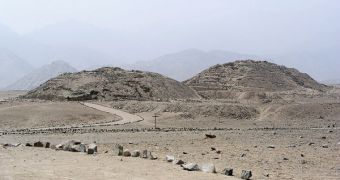The Ancient Pre-Columbian Society of the Supe, which reigned supremely in a part of modern-day Peru in a period of time stretching from approximately 3000 to 1800 BC, is now believed to have been annihilated by a devastating series of natural disasters, including earthquakes and massive floods, which forced the population to abandon its once-fertile lands, and prompted the downfall of its entire civilization. This happened more than 1,000 years before the next great American civilization, the Chavin, appeared and filled in the gap left behind by the Supe.
“This maritime farming community had been successful for over 2,000 years, they had no incentive to change, and then all of a sudden, boom, they just got the props knocked out from under them,” University of Florida anthropologist Mike Moseley, who has been involved in recent excavations at the site, says.
In the Tuesday issue of the Proceedings of the National Academy of Sciences journal, he and his colleagues report that the ancient population lived in a flourishing land, near beautiful estuaries and small golfs in the coast, which provided them with everything they needed to feed themselves. Furthermore, they had intricate irrigation systems, which ensured that their crops were safe from droughts.
In a cataclysm that occurred some 3,800 years ago, a massive earthquake, or maybe even a series of smaller tremors, prompted a wave of events that changed their society for the worse. Following the shakes, archaeological pieces of evidence seem to point to the fact that a massive flood might have taken place, which would have made their harvest inedible. Blowing sand could have made it impossible for them to grow any more crops, while landslides triggered by the earthquake forced debris into streams and made their water unfit for use.
Sediments carried from the mountains by the rivers clogged the beautiful estuaries, and the deprivation that the Supe eventually suffered led to its demise. Many abandoned the rich cities and sought their fame in other parts of the region, and, thus, all that now remains of the once-flourishing culture are a few pyramid ruins and a number of large sunken circular plazas.

 14 DAY TRIAL //
14 DAY TRIAL //